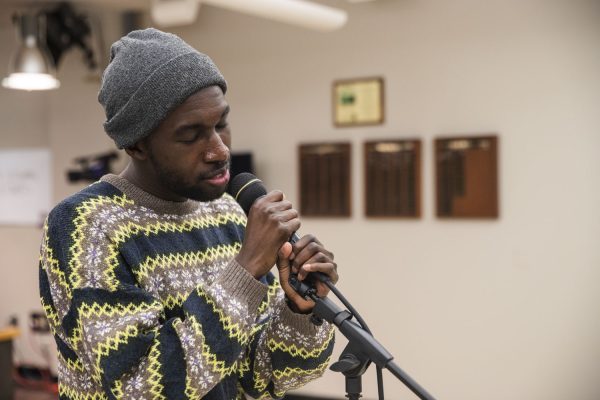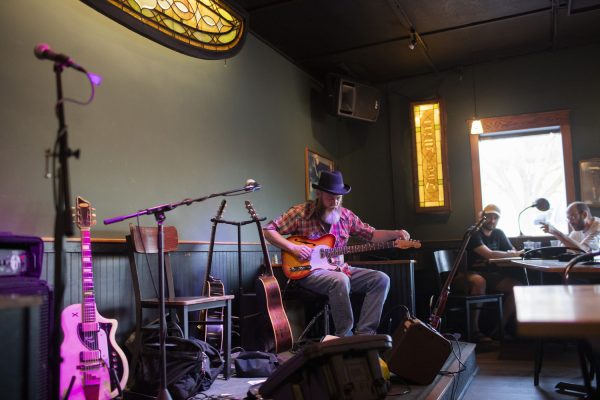Artists create Iowa-themed art to celebrate the state’s 175th anniversary
Artists collaborated with the “Annals of Iowa” to create a magazine showcasing visual art and written work, each highlighting an aspect of life in Iowa.
Photo illustration by Jerod Ringwald.
December 14, 2021
To celebrate the 175th anniversary of Iowa’s statehood, the Annals of Iowa — a quarterly published history magazine — will unveil a special edition in collaboration with the Iowa Arts Council for the first time in the publication’s history.
Typically, the Annals of Iowa features written work about the state. For this edition, essays and visual art inserts will be united under 11 categories, including religion, politics, and agriculture.
Annals of Iowa editor Andrew Klumpp said the selection process involved three key criteria: how well the work fit with the selected topic, how well the work would fit in a magazine format, and if the work’s art style would add variety to the magazine.
He said of the many submissions the publication received, 16 artists were selected for inserts, and one was selected for the cover.
“This was the first time that we’ve ever done a collaboration like this, between the Iowa Arts Council and the Annals of Iowa, so we weren’t quite sure what to expect for a response, but we were just delighted by the response we received from Iowa artists,” Klumpp said.
Two former University of Iowa graduates will see their work published in the Annals of Iowa special edition.
When Nancy Purington, UI graduate and visiting professor for textile arts, heard that the publication was seeking submissions, the agriculture category resonated with her.
“I grew up in Iowa, in the country, and I was always a visual learner,” Purington said. “I intensely observed the world around me as a child.”
Purington said she had a period of painting botanical subjects for a few years. During that time, she published the original version piece she submitted to the Annals of Iowa. The current version was digitally reworked in Photoshop and will be featured in the special edition entitled “Cross Pollination #104.”
The work features a geometric pattern with yellow corn kernels, a blue background representing ancient indigo dyeing practices, and a diagonal pattern connecting those elements.
RELATED: UI Symphony Orchestra celebrates 100th anniversary, looks to future
“Variations in botany is a language, and a way of life in Iowa,” she wrote in her artist statement for the special edition.
Multidisciplinary artist and UI graduate Akwi Nji also uses art to represent language. Her submission, which will be featured in the special edition, was pulled from her 2020 textbook series entitled “Textile Narrative.” Each piece is sized 5 inches by 7.5 inches, which mirrors the standard size of a memoir to represent that her visual work carries a narrative.
“It’s a story of who we are at the time that I was creating the piece — as a community, as a state, as a country,” Nji said.
Nji wanted to focus on the two events that affected her and her two teenage daughters most at the time: the COVID-19 pandemic and the murder of George Floyd. As a mother, she said she wanted to work through her thoughts and feelings on these issues so she could have conversations with her daughters about them.
“I had so many intellectual and emotional thoughts that were just getting jumbled up in my head and in my heart,” she said. “And the way I visualized it is like just a ball of yarn — the thread becoming more and more tangled the more I thought about everything.”
Nji found that her complicated feelings were easier to untangle when she put them into her art, she said.
“Creating the artwork was a way for those ideas and feelings that I was processing to really be sorted out,” Nji said. “Very literally using my hands to make sense of what my head and my heart could not make sense of.”
Nji said while the Black Lives Matter movement is certainly not unique to Iowa, it has roots here. She sees a through-line between Iowa’s involvement in the Underground Railroad and Black Iowans’ past and present, she said.
“What we are experiencing now is absolutely directly connected to centuries of history,” Nji said. “And so for me, it was a really intentional decision to try to create something that tied a historical context of race-relations to contemporary art.”













